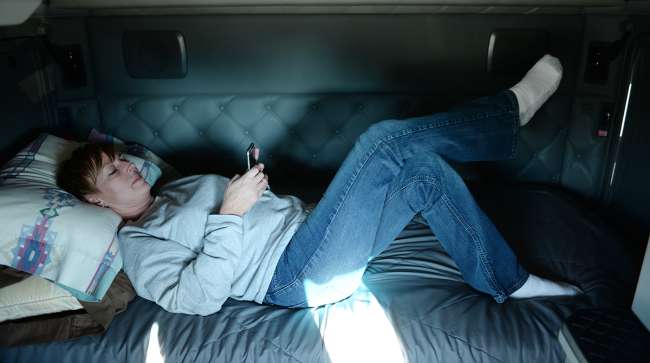Staff Reporter
ATRI Study Highlights Benefits of HOS Flexibility

Flexible hours-of-service breaks have the potential to benefit the drivers of sleeper berth trucks, according to a new analysis released by the American Transportation Research Institute on Aug. 28.
Current federal law requires drivers to rest for at least 10 hours before starting a new 14-hour workday. ATRI’s report suggests that certain “innovative HOS concepts” could help drivers avoid rush-hour congestion by taking strategic periods of rest.
ATRI’s report uses data to study how breaking up the 10-hour rest requirement, such as dividing rest hours into 7/3, 6/4 or 5/5 splits, would be effective in helping drivers avoid bottlenecks.
“[A] rest period of three or more hours that qualifies toward the daily 10-hour rest requirement could effectively help drivers avoid slow-moving peak travel periods,” ATRI’s report states. “The opportunity for a driver to adapt to changing conditions and congestion levels throughout a day is critical and could be greatly enhanced with the addition of flexible sleeper berth rules to the current HOS regulations.”
#ATRI Research Quantifies Benefits of Hours-of-Service Flexibility: Reduced Driving Time and Lower Costs https://t.co/DXKdFIiUpv. #trucking #truckingresearch — Rebecca Brewster (@ATRIPREZ) August 28, 2018
A 40-mile stretch of highway from northeast Atlanta along Interstate 85 to points west of the city along I-20 was ATRI’s testbed for the study. Truck GPS data revealed that it took drivers 40 to 90 minutes to traverse that corridor during rush hour. Drivers starting a trip along the route at 6 p.m. could expect to spend more than 90 minutes sitting in their vehicle, the study found.
Atlanta is home to two of the most congested freight bottlenecks in the country. The five-level stack interchange known as “Spaghetti Junction,” where I-285 and I-85 North intersect, ranked No. 1 on ATRI’s 2018 study on the 100 most congested truck bottlenecks in the country. The intersection of I-75 and I-285 North ranked No. 4.
The report suggests that flexible HOS rules would allow a driver to take a break for a few hours during peak traffic to avoid a congested urban corridor, such as the one in Atlanta. The driver then could save time and money by traversing the corridor faster when rush hour is over and the route is relatively clear.
“If only 25 truck trips per day avoided the congested weekday time period presented on the study segment, truck drivers would drive 4,700 fewer hours annually to move the same goods the same distance,” the report states. “This equates to operational cost savings of more than $300,000 per year for the 25-truck sample at that single location.”

Spaghetti Junction (NASA World Wind)
HOS flexibility is a common plea among truck drivers, demonstrated in the Federal Motor Carrier Safety Administration’s official request for comment on the subject issued in June 2017. Comments submitted to the Federal Register reflected a desire for more options to split rest times. Several drivers said that flexibility would increase safety.
“Being able to get some rest when, I feel, I need it would greatly increase my productivity and the safety of the public,” one respondent said in a Federal Register comment. “Playing ‘beat the clock’ when I have been held up, in traffic or at the dock, is not safe for anyone. With a change to the rules, I could count the six hours I spent sleeping in the dock waiting to be unloaded, toward my 10 [hour[ break and not have it be wasted time.”
The report also found that flexible HOS options can yield more than $150 million in operational cost savings a year.
ATRI’s analysis was a response to the institute’s Research Advisory Committee identifying flexibility in HOS regulations as a top research priority last year.
“ATRI’s findings confirm what drivers have consistently said about these rules since they went into effect: The lack of flexibility has the potential to hinder safety and productivity,” said Dan Horvath, vice president of safety policy for American Trucking Associations. “We look forward to this data informing the current debate on Capitol Hill and at the Department of Transportation about the future of the hours-of-service rules.”




